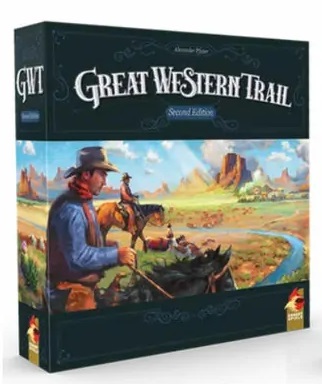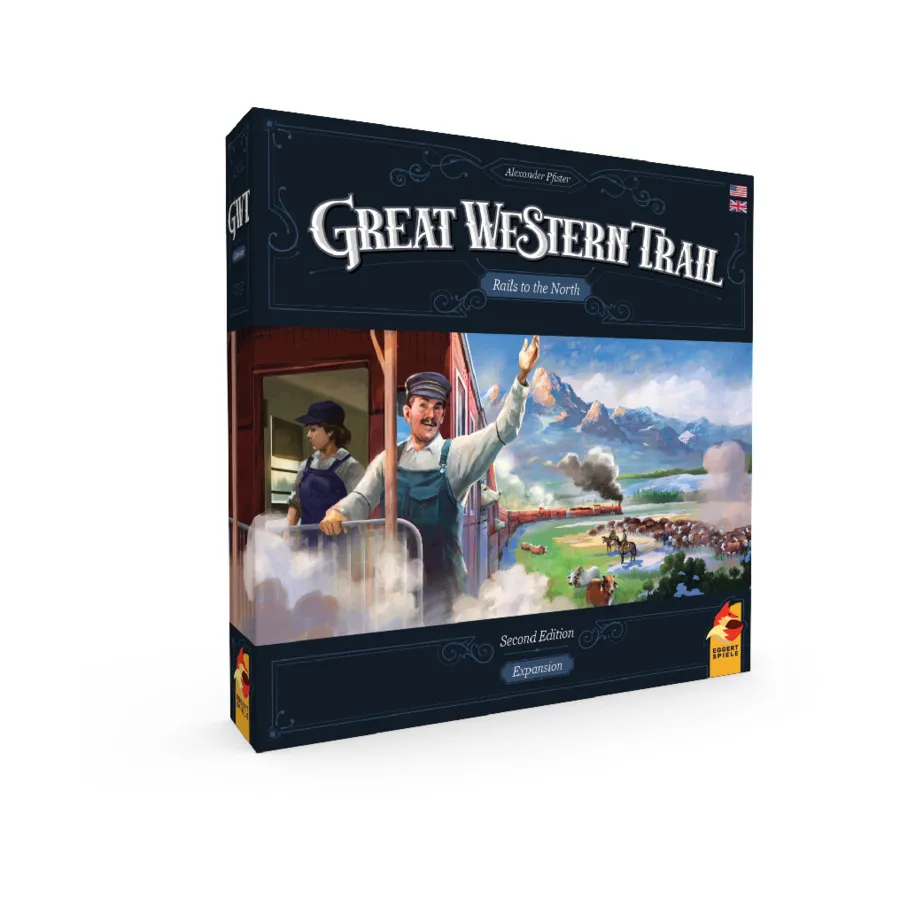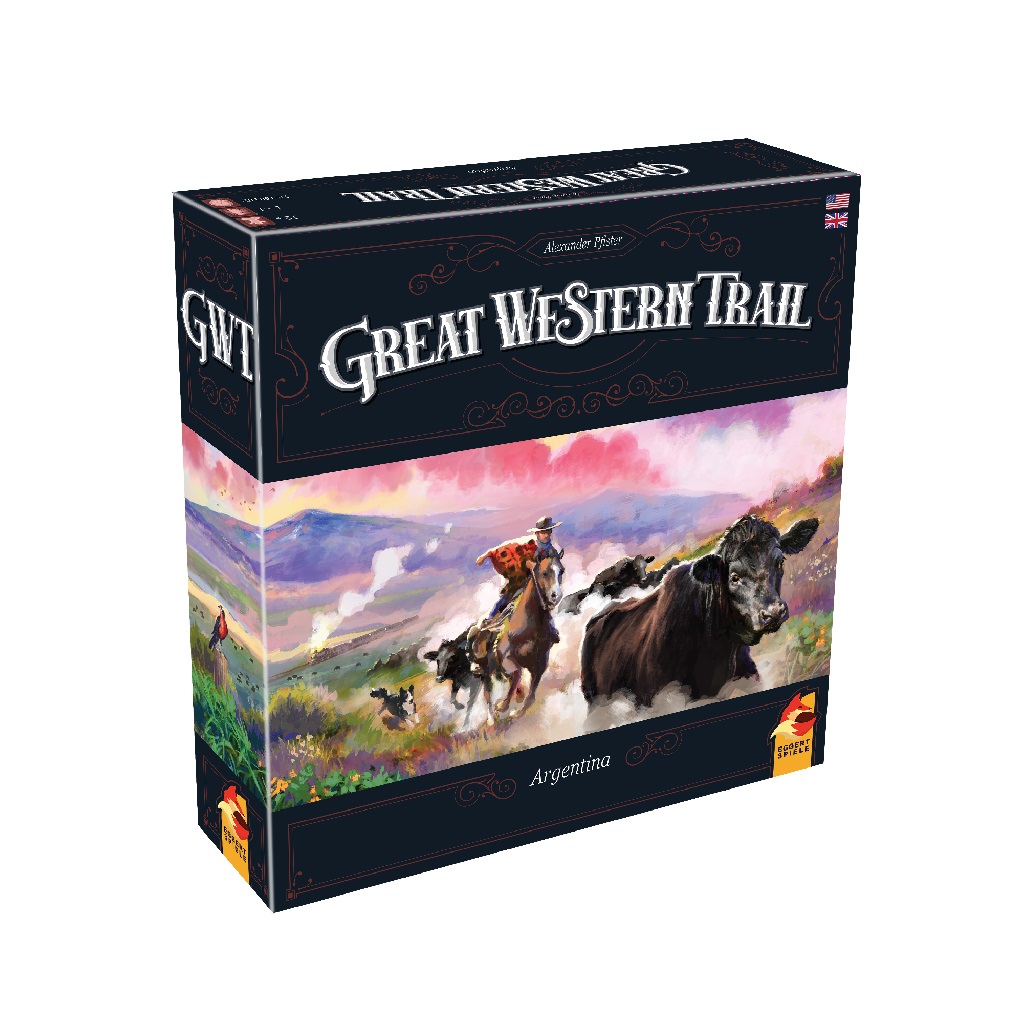Do you like deck building, animals, and crunchy interaction in your euro games? If so, then Alexander Pfister’s Great Western Trail series might be worth rustling up for your collection.
The Many Mechanics of Great Western Trail
Great Western Trail does what many excellent euros do: meld various mechanisms into a thematically tight bundle of fun. Here, you’ll be taking your cowboy  and driving cattle (or sheep, in Great Western Trail New Zealand) on a point-to-point rondel every turn, choosing where to stop and taking actions based on the space. You might earn some needed cash, trade in a cow from your hand to get some bonuses, or hire a specialist to boost your player powers. At the game’s start, everyone will be coming from a roughly equal spot, the only variance coming in that initial drawn hand
and driving cattle (or sheep, in Great Western Trail New Zealand) on a point-to-point rondel every turn, choosing where to stop and taking actions based on the space. You might earn some needed cash, trade in a cow from your hand to get some bonuses, or hire a specialist to boost your player powers. At the game’s start, everyone will be coming from a roughly equal spot, the only variance coming in that initial drawn hand
As a deck builder, Great Western Trail gives you a starting stack of ten cows, each with a different color (breed) worth different amounts of points. Some spaces might let you discard a green cow for several coins, or ditch two cows of the same color for more. What you have in hand, therefore, helps guide the spaces you’ll aim for en route to the path’s end and the big delivery, which rewards a varied hand with cash and a chance to clear a disc off your player board, giving you better abilities, larger hand sizes, or increased move speed.
That move speed gets important as Great Western Trail goes on, as the path from start to end will get crowded as you and your fellow players construct new buildings. These custom spaces only serve their owners, and often take tolls from other players, creating a meta game where each of you will be blocking each other, crafting a perfect route, or ignoring them altogether in favor of growing the best cattle herd.
Great Western Trail has a player-controlled pace, with deliveries to the last stop serving to tick along the game’s timer. This nifty bit lets you take a look around, guess at your opponent’s strategies, and decide to rush an end or slow roll as much as possible to let your cattle empire come to fruition. All this rolls along at a good clip, with little action chaining or wild board shifts that might drive analysis paralysis. Yet, because almost all of Great Western Trail’s board elements are shared (e.g. you buying the coolest cow will keep your buddy from doing the same), this is very much not a solitaire experience – your plans will be messed with, and you, in turn, will nudge opponents off their game.
That said, this isn’t Food Chain Magnate or Barrage. You’ll hit bumps on the trail, but won’t find yourself stampeding off a cliff.
Altogether, then, Great Western Trail’s gameplay herd is a couple hours of good game for anyone ready to ride with a medium-weight euro’s complexity. The sort of thing you might venture into after Everdell, The White Castle, or The Lost Ruins of Arnak. The question, then, is which trail would you prefer?
Argentina, New Zealand, and Rails to the North
Great Western Trail 2nd Edition is going to be your best entry point, as it’s a polished revision of the (still excellent) original. This edition smooths out the game’s start and adds some minor balancing hits while updating the box art to look sharp on any shelf. Start here and then, if you’re addicted to the cattle drive after a few plays, grab the Rails to the North expansion.
drive after a few plays, grab the Rails to the North expansion.
Rails to the North expands the delivery bonuses of the original game into a branching series of decisions, where sending your cows to, say, Cincinnati instead of Chicago is a real decision rather than just the value you happened to end up with at the end. You’ll build routes with your deliveries, essentially expanding a network that’ll combo into bigger bonuses if your herd hits the mark. It’s a great expansion, fleshing out a thinner element of the original with minimal extra rules burden.
After those two, or if you’d prefer a change of scenery, Great Western Trail: Argentina builds on its brother with a new worker type (farmers) and more agency en route to delivering your cows to Buenos Aires. Because the core mechanics are the same, you’ll be able to jump right into this one, but if you’re thinking of starting here, be aware there’s simply more going on from the jump with Argentina. It’s not a Lacerda, but for those wanting more crunch with their cattle, Argentina’s going to give it.
One other note – if you’re a solo player, Argentina offers a dedicated, score-beating solitaire mode.
If you’d rather ditch the cattle for sheep, the recent Great Western Trail: New Zealand brings a leveling change to the original’s sturdy core. More point salad than the original, New Zealand is friendlier to multiple strategies and sandbox play. Having more opportunity to combine paths, like sheep varieties with high  quality buildings, presents a sprawling decision space, but one that falls into place quickly throughout a first play. Doing well remains a challenge, but pulling off satisfying combos in New Zealand is a treat.
quality buildings, presents a sprawling decision space, but one that falls into place quickly throughout a first play. Doing well remains a challenge, but pulling off satisfying combos in New Zealand is a treat.
Should you feel the call of the cows but want something a little more approachable, Great Western Trail: El Paso is coming later this year. By slimming down most of its big brothers’ elements, El Paso trims the game length to an hour and eases the teach. Personally, I’d give the original a go first and, if you like that, use El Paso as an intro to newer board gamers as an on ramp to a great series.
Other Games like Great Western Trail
If you’re a ranching expert and want something similar to Great Western Trail, here’s a few titles that match GWT’s blend of tight theming with multiple euro mechanisms. All of these hit a similar weight too, meaning if your group’s good with the cows, they’ll have an easy time jumping into any of these winners:
Darwin’s Journey: A Spiel Des Jahres winner, Darwin’s Journey is a combo-tastic worker placement game wherein you’ll be researching specimens, exploring islands, and fulfilling contracts while walking a financial tightrope. Addictive with enchanting production design, Darwin’s Journey is an eye-catching good time.
Anachrony: Time-travel and apocalyptic worker placement might not seem akin to Great Western Trail, but Mindclash Games’ classic offers a similar blend of strategy with multiple paths to victory. You’ll build up your faction’s abilities, compete with everyone else for spots and resources, and ultimately attempt to escape a shredded world. Numerous modules lets Anachrony grow with every play until it hits the sweet sci-fi strategy spot your group is looking for.
Maracaibo: In some ways a direct follow-up to Great Western Trail, Pfister’s Caribbean pseudo-sequel transports Great Western Trail’s rondel to the pirate-ridden sea. You’ll be angling to swing England, Spain, or France into your favor while raiding towns, completing orders, and amassing wealth. The unique movement mechanic sees greater rewards for skipping more spaces, giving you the chance to dash ahead of opponents to snag a critical port. Pirates of Maracaibo, a slimmed-down pseudo-sequel, came out last year too if you’d prefer a faster version.
Skymines: A Pfister remake of Mombasa, this 2022 sci-fi euro has you managing a hand of action cards in programmatic style, meaning you and your pals will be dropping cards face down simultaneously and then revealing them to gain influence in companies, gather resources, buy more powerful cards, and generally assist in the takeover of the Moon. Because you’re all working with the same companies, similar to an 18XX title (and a gateway of sorts to that board gaming sector), timing your efforts and investment to maximize returns is key. Tight, interactive, and with mild campaign elements, Skymines is a worthy evolution of a classic.
be dropping cards face down simultaneously and then revealing them to gain influence in companies, gather resources, buy more powerful cards, and generally assist in the takeover of the Moon. Because you’re all working with the same companies, similar to an 18XX title (and a gateway of sorts to that board gaming sector), timing your efforts and investment to maximize returns is key. Tight, interactive, and with mild campaign elements, Skymines is a worthy evolution of a classic.
Ark Nova: Building a zoo has never been so addicting as in this 2021 puzzler, where you’ll dig through a vast deck of cards for the right animal or sponsor, manage a strict set of rotating actions, and develop a board covered in bonuses. Excellent for solo play or longer sessions with a group that doesn’t mind a more solitaire experience, Ark Nova is flexible, fun, and rewarding. The recent Marine Worlds expansion helps that deck delving too, ensuring you’re not left in the lurch if the card draw doesn’t get you the monkeys you so desperately crave.
Great Western Trail and its various editions offer up a great game night meal, something playable any night of the week that feels substantial, rewards strategy over blind luck, and keeps everyone at the table engaged. While the standard 2nd edition offers the best shot for new cowpokes, expanding to Argentina and New Zealand revives a great ruleset with fresh features and deeper mechanisms. Regardless of where you decide to saddle up, though, you won’t go wrong.
Read our previous article here!
